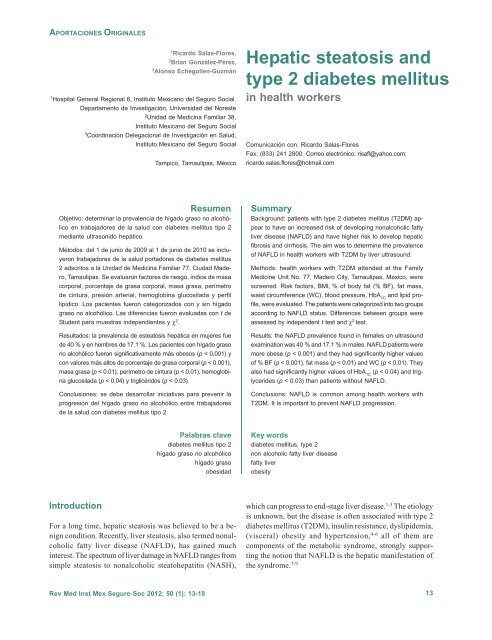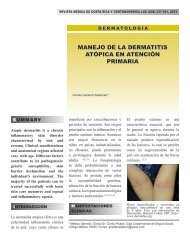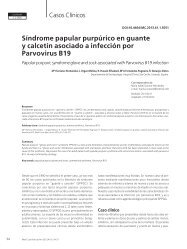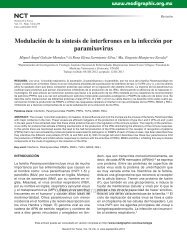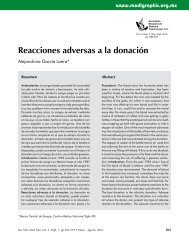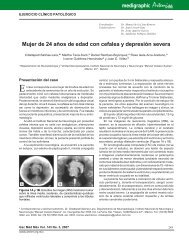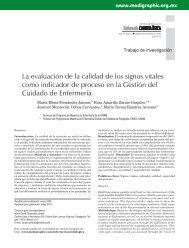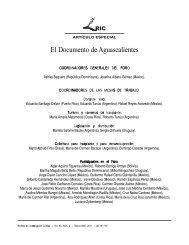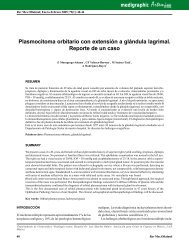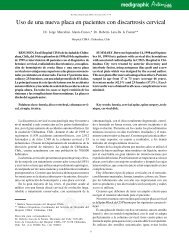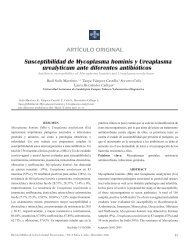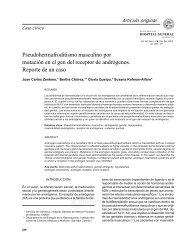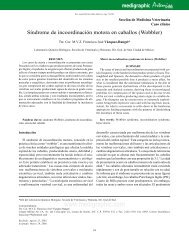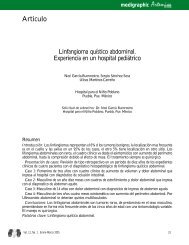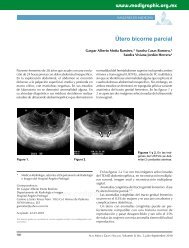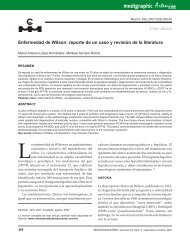Hepatic steatosis and type 2 diabetes mellitus - edigraphic.com
Hepatic steatosis and type 2 diabetes mellitus - edigraphic.com
Hepatic steatosis and type 2 diabetes mellitus - edigraphic.com
You also want an ePaper? Increase the reach of your titles
YUMPU automatically turns print PDFs into web optimized ePapers that Google loves.
APORTACIONES ORIGINALES<br />
1 Ricardo Salas-Flores,<br />
2 Brian González-Pérez,<br />
3 Alonso Echegollen-Guzmán<br />
1Hospital General Regional 6, Instituto Mexicano del Seguro Social.<br />
Departamento de Investigación, Universidad del Noreste<br />
2Unidad de Medicina Familiar 38,<br />
Instituto Mexicano del Seguro Social<br />
3Coordinación Delegacional de Investigación en Salud,<br />
Instituto Mexicano del Seguro Social<br />
Tampico, Tamaulipas, México<br />
Resumen<br />
Objetivo: determinar la prevalencia de hígado graso no alcohólico<br />
en trabajadores de la salud con <strong>diabetes</strong> <strong>mellitus</strong> tipo 2<br />
mediante ultrasonido hepático.<br />
Métodos: del 1 de junio de 2009 al 1 de junio de 2010 se incluyeron<br />
trabajadores de la salud portadores de <strong>diabetes</strong> <strong>mellitus</strong><br />
2 adscritos a la Unidad de Medicina Familiar 77, Ciudad Madero,<br />
Tamaulipas. Se evaluaron factores de riesgo, índice de masa<br />
corporal, porcentaje de grasa corporal, masa grasa, perímetro<br />
de cintura, presión arterial, hemoglobina glucosilada y perfil<br />
lipídico. Los pacientes fueron categorizados con y sin hígado<br />
graso no alcohólico. Las diferencias fueron evaluadas con t de<br />
Student para muestras independientes y χ2 .<br />
Resultados: la prevalencia de e<strong>steatosis</strong> hepática en mujeres fue<br />
de 40 % y en hombres de 17.1 %. Los pacientes con hígado graso<br />
no alcohólico fueron significativamente más obesos (p < 0.001) y<br />
con valores más altos de porcentaje de grasa corporal (p < 0.001),<br />
masa grasa (p < 0.01), perímetro de cintura (p < 0.01), hemoglobina<br />
glucosilada (p < 0.04) y triglicéridos (p < 0.03).<br />
Conclusiones: se debe desarrollar iniciativas para prevenir la<br />
progresión del hígado graso no alcohólico entre trabajadores<br />
de la salud con <strong>diabetes</strong> <strong>mellitus</strong> tipo 2.<br />
Introduction<br />
Palabras clave<br />
<strong>diabetes</strong> <strong>mellitus</strong> tipo 2<br />
hígado graso no alcohólico<br />
hígado graso<br />
obesidad<br />
For a long time, hepatic <strong>steatosis</strong> was believed to be a benign<br />
condition. Recently, liver <strong>steatosis</strong>, also termed nonalcoholic<br />
fatty liver disease (NAFLD), has gained much<br />
interest. The spectrum of liver damage in NAFLD ranges from<br />
simple <strong>steatosis</strong> to nonalcoholic steatohepatitis (NASH),<br />
<strong>Hepatic</strong> <strong>steatosis</strong> <strong>and</strong><br />
<strong>type</strong> 2 <strong>diabetes</strong> <strong>mellitus</strong><br />
in health workers<br />
Comunicación con: Ricardo Salas-Flores<br />
Fax: (833) 241 2800. Correo electrónico: risafl@yahoo.<strong>com</strong>;<br />
ricardo.salas.flores@hotmail.<strong>com</strong><br />
Summary<br />
Background: patients with <strong>type</strong> 2 <strong>diabetes</strong> <strong>mellitus</strong> (T2DM) appear<br />
to have an increased risk of developing nonalcoholic fatty<br />
liver disease (NAFLD) <strong>and</strong> have higher risk to develop hepatic<br />
fibrosis <strong>and</strong> cirrhosis. The aim was to determine the prevalence<br />
of NAFLD in health workers with T2DM by liver ultrasound.<br />
Methods: health workers with T2DM attended at the Family<br />
Medicine Unit No. 77, Madero City, Tamaulipas, Mexico, were<br />
screened. Risk factors, BMI, % of body fat (% BF), fat mass,<br />
waist circumference (WC), blood pressure, HbA <strong>and</strong> lipid pro-<br />
1C<br />
file, were evaluated. The patients were categorized into two groups<br />
according to NAFLD status. Differences between groups were<br />
assessed by independent t test <strong>and</strong> χ2 test.<br />
Results: the NAFLD prevalence found in females on ultrasound<br />
examination was 40 % <strong>and</strong> 17.1 % in males. NAFLD patients were<br />
more obese (p < 0.001) <strong>and</strong> they had significantly higher values<br />
of % BF (p < 0.001), fat mass (p < 0.01) <strong>and</strong> WC (p < 0.01). They<br />
also had significantly higher values of HbA (p < 0.04) <strong>and</strong> trig-<br />
1C<br />
lycerides (p < 0.03) than patients without NAFLD.<br />
Conclusions: NAFLD is <strong>com</strong>mon among health workers with<br />
T2DM. It is important to prevent NAFLD progression.<br />
Key words<br />
<strong>diabetes</strong> <strong>mellitus</strong>, <strong>type</strong> 2<br />
non alcoholic fatty liver disease<br />
fatty liver<br />
obesity<br />
which can progress to end-stage liver disease. 1-3 The etiology<br />
is unknown, but the disease is often associated with <strong>type</strong> 2<br />
<strong>diabetes</strong> <strong>mellitus</strong> (T2DM), insulin resistance, dyslipidemia,<br />
(visceral) obesity <strong>and</strong> hypertension, 4-6 all of them are<br />
<strong>com</strong>ponents of the metabolic syndrome, strongly supporting<br />
the notion that NAFLD is the hepatic manifestation of<br />
the syndrome. 7-9<br />
Rev Med Inst Mex Seguro Soc 2012; 50 (1): 13-18 13
Most patients with NAFLD are asymptomatic. Although<br />
some may experience malaise on right upper-quadrant in abdominal<br />
region. 10 NAFLD is generally diagnosed by<br />
ultrasonographic that has a sensitivity of 90 % <strong>and</strong> specificity<br />
95 % in detection moderate <strong>and</strong> severe hepatic <strong>steatosis</strong>. 11<br />
The prevalence of NAFLD in T2DM is unknown. However<br />
it has been estimated that 70-75 % of T2DM patients may<br />
have NAFLD. 12 In Mexico the prevalence is unknown maybe<br />
because is underestimated for his association with T2DM <strong>and</strong><br />
obesity which are very <strong>com</strong>mon in Mexican population.<br />
All patients who have T2DM or are severely obese appear<br />
to have an increased risk of developing NAFLD <strong>and</strong> certainly<br />
have a higher risk of developing hepatic fibrosis <strong>and</strong> cirrhosis.<br />
Currently, NAFLD has gained interest because of its asymptomatic<br />
evolution, in the identification of a clinical pattern <strong>and</strong><br />
to prevent progression to liver failure, cirrhosis <strong>and</strong> to hepatocellular<br />
carcinoma. 13 Considering that these <strong>com</strong>plications<br />
constitute a substantial decrease in quality of life <strong>and</strong> life<br />
expectancy <strong>and</strong> accounts it high cost in health care budget,<br />
one of the mayor problems to resolve is the prevalence of<br />
NAFLD which is unknown in our health worker <strong>com</strong>munity,<br />
the purpose was to determine the prevalence of NAFLD<br />
among health workers with T2DM diagnosed by liver<br />
ultrasound, which is the most widely used imaging test for<br />
detecting hepatic <strong>steatosis</strong>.<br />
Methods<br />
All health workers with T2DM attended at the Family Medicine<br />
Unit No. 77, Madero City, Tamaulipas, Mexico, from June<br />
1st 2009 to June 1st 2010 were screened. Patients with history<br />
of hepatitis infection, liver cirrhosis, pregnant women <strong>and</strong> those<br />
who have not laboratory tests <strong>and</strong> liver ultrasound image were<br />
excluded. An informed consent was obtained. A questionnaire<br />
was applied to patients who accepted to participate. They were<br />
referred to an endocrinologist in the General Regional Hospital<br />
No.6, Mexican Institute of Social Security for medical evaluation<br />
<strong>and</strong> hepatic ultrasound. The local ethics <strong>com</strong>mittee 2801<br />
approved the study.<br />
In the st<strong>and</strong>ing position, weight <strong>and</strong> height were measured<br />
with the subjects in light clothing <strong>and</strong> without shoes. Body<br />
weight was measured recorded to the nearest 0.1 kg using a<br />
digital scale (Tanita Corporation, Japan). Height was obtained<br />
by using a portable stadiometer 225 cm (SECA, Hamburg,<br />
Germany) to nearest 0.1 cm. Adiposity was measured by<br />
bioelectrical impedance analysis using a TANITA TBF310<br />
model with a frequency of 50 kHz. Height, sex <strong>and</strong> age were<br />
entered manually, while weight was recorded automatically<br />
using 0.5 kg as an adjustment for clothing weight in all subjects.<br />
Body mass index (BMI) was calculated by dividing weight<br />
in kilograms by the square of height in meters. Waist<br />
14<br />
Salas-Flores R et al. <strong>Hepatic</strong> <strong>steatosis</strong> <strong>and</strong> <strong>diabetes</strong><br />
circumference (WC) was measured in a st<strong>and</strong>ing position at<br />
the level of the umbilicus. Blood pressure was measured with<br />
a st<strong>and</strong>ard mercury manometer. Venous blood was drawn in<br />
the morning after an overnight fast. Plasma glucose concentrations<br />
were measured using the glucose oxidase method, total<br />
cholesterol, HDL cholesterol <strong>and</strong> LDL cholesterol by<br />
enzymatic reaction, triglycerides by a colorimetric method <strong>and</strong><br />
HbA 1C by chromatography (Syncron CX 4; Beckman<br />
Instruments, Fullerton, CA).<br />
The hepatic <strong>steatosis</strong> evaluation was made by ultrasound.<br />
The apparatus used (TOSHIBA) was equipped with a convex<br />
3.5 MHz probe. Longitudinal, sub-costal, ascending, <strong>and</strong><br />
oblique scans were performed always by the same experienced<br />
radiologist, who was unaware of the clinical course <strong>and</strong><br />
laboratory details of the patients.<br />
Overweight was defined as a BMI > 25 < 29.9 kg/m 2 <strong>and</strong><br />
obesity if BMI > 30 kg/m 2 . 14 A WC > 90 cm in men <strong>and</strong> > 84 cm<br />
in women was considered as abdominal obesity. 15 Blood<br />
pressure was considered high if the systolic was > 130 mm Hg<br />
or diastolic was > 80 mm Hg according to our guides for institutional<br />
clinical practice. 16 The diabetic control was considered<br />
good with HbA 1C values < 7 %, total cholesterol < 200 mg/dL,<br />
LDL cholesterol < 100 mg/dL, HDL cholesterol > 40 mg/dL<br />
in men <strong>and</strong> > 50 mg/dL in women, triglycerides < 150 mg/Dl. 17,18<br />
The criteria for determining the presence of <strong>steatosis</strong> was the<br />
hyperechogenicity of the liver tissue with tightly packed fine<br />
echoes <strong>and</strong> hepatomegaly. 19<br />
The patients were categorized into two groups according<br />
to NAFLD status. Descriptive data were expressed as mean<br />
values ± SD for continuous variables <strong>and</strong> number of subjects<br />
(percentage) for categorical variables. Differences between<br />
groups were assessed by independent t test <strong>and</strong> χ 2 test using<br />
SPSS statistical software (version 12; SPSS Inc, Chicago IL,<br />
USA). All reported with p values < 0.05 were considered<br />
statistically significant.<br />
Results<br />
Fifty eight health workers were identified, four were not<br />
contacted <strong>and</strong> 19 patients declined to participate in the study<br />
or not <strong>com</strong>plete the liver ultrasound examination or<br />
laboratory test. A total of 35 health workers aged 31-58 years<br />
were included in the analysis. The baseline characteristics<br />
of the study participants grouped according to NAFLD status<br />
were in table I, the prevalence of ultrasonography hepatic<br />
<strong>steatosis</strong> was found in 57.1 % (n = 20) of patients. Individuals<br />
with hepatic <strong>steatosis</strong> were younger, more frequent<br />
females (n = 14) <strong>and</strong> the proportion using oral hypoglycemic<br />
agents was higher among patients with NAFLD (n = 20).<br />
They also had significantly higher values of BMI, % BF,<br />
fat mass <strong>and</strong> WC. They were significantly more obese <strong>and</strong><br />
present high values of blood pressure. Accordingly, patients<br />
Rev Med Inst Mex Seguro Soc 2012; 50 (1): 13-18
Salas-Flores R et al. <strong>Hepatic</strong> <strong>steatosis</strong> <strong>and</strong> <strong>diabetes</strong><br />
Table I Characteristics of the study participants, grouped according to nonalcoholic fatty liver disease status*<br />
Variables Without NAFLD With NAFLD p**<br />
n 15 20 –<br />
Sex (% F/M) 22.8/20 40/17.1 ns<br />
Age (years)* 49.73 ± 7.3 44.40 ± 6.5 0.03<br />
Oral hypoglycemic users (%) 37.1 57.1 ns<br />
Insulin users (%) 5.7 0<br />
BMI* 28.81 ± 3 34.56 ± 7.07<br />
Overweight (%) 31.4 14.2 0.005<br />
Obesity (%) 11.4 42.8<br />
% Body fat* 28.94 ± 7.2 38.79 ± 8.2 0.001<br />
Fat mass (kg)* 25.04 ± 8 35.1 ± 13.4 0.01<br />
Waist circumference (cm)* 96 ± 10.2 107 ± 14.2 0.01<br />
Systolic blood pressure (mm Hg)* 128.67 ± 15.5 133.35 ± 14.03 ns<br />
Diastolic blood pressure (mm Hg)* 82.3 ± 7.7 85 ± 9.1 ns<br />
HbA 1C (%)* 6.68 ± 1.5 7.92 ± 2.02 0.04<br />
Triglycerides (mg/dL)* 153 ± 60.1 221.1 ± 105.5 0.03<br />
Total cholesterol (mg/dL)* 195.26 ± 34.8 201.1 ± 31.07 ns<br />
HDL cholesterol (mg/dL)* 43.2 ± 10.3 39.15 ± 7.1 ns<br />
LDL cholesterol (mg/dL)* 119.44 ± 43.6 139.3 ± 22.1 ns<br />
Good diabetic control (%) 20 0 0.001<br />
Bad diabetic control (%) 22.8 57.1<br />
* Data are mean ± SD or proportions.<br />
** Statically significant p < 0.05 (independent test for continuous variables <strong>and</strong> χ 2 test for categorical variables).<br />
HDL = high-density lipoprotein, LDL = low-density lipoprotein, HbA 1C = glycated hemoglobin<br />
Rev Med Inst Mex Seguro Soc 2012; 50 (1): 13-18<br />
15
with NAFLD had significantly higher values of HbA 1C <strong>and</strong><br />
triglycerides. Plasma HDL cholesterol, LDL cholesterol <strong>and</strong><br />
total cholesterol concentrations were not significantly different<br />
between the groups. Bad diabetic control occurred more<br />
frequently among patients with NAFLD.<br />
Discussion<br />
NAFLD is the most <strong>com</strong>mon cause of chronic liver disease<br />
in adults <strong>and</strong> is frecuently associated with obesity, metabolic<br />
syndrome <strong>and</strong> T2DM. 20 The prevalence of NAFLD among<br />
T2DM patients has been estimated 34-74 % <strong>and</strong> it is an almost<br />
universal finding in obese patients with T2DM. 21 In Mexico,<br />
there are few studies on the frequency of NAFLD in population<br />
with <strong>diabetes</strong>, which is estimated at 10.3 cases per 100<br />
inhabitants in general population <strong>and</strong> 18.5 cases in population<br />
with <strong>diabetes</strong>. 22 In the present study, we found a high<br />
prevalence of NAFLD as diagnosed by means of characteristic<br />
sonographic features in health workers with T2DM <strong>com</strong>pared<br />
with reported by Bernal et al. <strong>and</strong> Roesch et al. 22,23 <strong>and</strong><br />
similar presence of NAFLD in females. Contrary to reported<br />
in others studies we found that patients with NAFLD were<br />
younger. 24 We consider this finding of concern because early<br />
presentation of NAFLD represents an important burden of<br />
disease for health workers.<br />
Another finding was the increased % BF <strong>and</strong> abdominal<br />
obesity, which suggest the presence of NAFLD. In most studies,<br />
liver fat is closely <strong>and</strong> positively correlated with measures of<br />
total adiposity such as BMI or percentage body fat. Furthermore,<br />
the correlation of liver fat with visceral adiposity, measured as<br />
waist circumference, is particularly strong. 25-27<br />
The liver fat content in T2DM patients could contribute<br />
to diabetic dyslipidemia. Serum triglycerides <strong>and</strong>/or LDL<br />
cholesterol levels might be elevated in patients with NAFLD.<br />
In our study, serum triglyceride levels were found significantly<br />
higher in patients with NAFLD. In other studies, hyperlipemia<br />
prevalence was detected as varying between 21-44 % in<br />
the patients with NAFLD. 28<br />
Fatty liver results from accumulation of fatty acids in various<br />
forms, predominantly triglycerides. This accumulation occurs<br />
when there is a shift in fatty acid metabolism to favor net<br />
lipogenesis rather than lipolysis. This can occur when the amount<br />
of fatty acid supplied to the liver from the gut or adipose tissue<br />
exceeds the amount needed for mitochondrial oxidation,<br />
phospholipids <strong>and</strong> cholesterol ester synthesis. This is the<br />
presumed mechanism for <strong>steatosis</strong> in the setting of <strong>diabetes</strong><br />
<strong>mellitus</strong>, obesity, malnutrition, parenteral nutrition, steroid treatment<br />
<strong>and</strong> excessive dietary intake of fat. Hyperinsulinism <strong>and</strong><br />
insulin resistance is an important <strong>com</strong>ponent in the development<br />
of <strong>steatosis</strong> in these diseases. It has been demonstrated that<br />
a fatty liver is insulin resistant, resulting in elevated HbA 1C values<br />
<strong>and</strong> therefore a bad control of <strong>diabetes</strong>. 29<br />
16<br />
Salas-Flores R et al. <strong>Hepatic</strong> <strong>steatosis</strong> <strong>and</strong> <strong>diabetes</strong><br />
This study is the first to describe the NAFLD prevalence<br />
in health workers with T2DM in Tamaulipas State.<br />
Overall, our results suggest that NAFLD is very <strong>com</strong>mon<br />
among T2DM health workers with a poor diabetic control.<br />
These findings might have possible clinical <strong>and</strong> public health<br />
implications. We suggested that a consideration should be<br />
given to referring our health workers with priority to endocrino-logist<br />
<strong>and</strong> gastroenterologist for further evaluation.<br />
This will be particularly important once an effective treatment<br />
for NASH has been established, <strong>and</strong> better noninvasive<br />
methods for assessing disease severity are validated. It is<br />
important to develop innovative <strong>and</strong> interventionist initiatives<br />
in liver disease management approaches to prevent<br />
progression to NAFLD. The Family Medicine Units have<br />
an important work in health promotion, prevention, early<br />
detection <strong>and</strong> control, <strong>and</strong> also in the early treatment of<br />
<strong>diabetes</strong> <strong>and</strong> its <strong>com</strong>plications. The activities developed to<br />
preventing the <strong>com</strong>plications of <strong>diabetes</strong> <strong>and</strong> improving the<br />
health out<strong>com</strong>es for our health workers would be (when <strong>diabetes</strong><br />
is under effective management), to be more productive,<br />
positively contribute to their family life, to their place of<br />
employment <strong>and</strong> their <strong>com</strong>munity. They would also favored<br />
a better quality of life to patients.<br />
The study has some limitations that should be noted. The<br />
diagnosis of NAFLD was based on ultrasound imaging <strong>and</strong><br />
the exclusion of other causes of chronic liver disease was<br />
based on self-report by the patients such a viral hepatitis or<br />
liver cirrhosis but were not confirmed by liver biopsy. It is<br />
known that none of the radiological features can distinguish<br />
between NASH <strong>and</strong> other forms of NAFLD <strong>and</strong> that only<br />
liver biopsy can assess the severity of damage <strong>and</strong> the<br />
prognosis. However, liver biopsy would be impossible to<br />
perform routinely in a large epidemiological study. Conversely,<br />
ultrasonographic is by far the most <strong>com</strong>mon way of<br />
diagnosing NAFLD in clinical practice <strong>and</strong> has good sensitivity<br />
<strong>and</strong> specificity in detecting moderate <strong>and</strong> severe<br />
<strong>steatosis</strong>. Indeed, it has been reported that the presence of<br />
more than 30 % fat on liver biopsy is optimal for ultrasound<br />
detection of <strong>steatosis</strong>, whereas ultrasonographic is not totally<br />
sensitive, particularly when hepatic fat infiltration is <<br />
30 %. 30 Thus; it is likely that we misclassified patients with<br />
NAFLD based only on ultrasonographic. On the other h<strong>and</strong><br />
we did not know the <strong>type</strong> of insulin <strong>and</strong> antidiabetic agents<br />
<strong>and</strong> how this may have affected our results, mainly because<br />
it has been proposed that metformin has shown beneficial<br />
effects in lowering hepatic <strong>steatosis</strong>.<br />
Acknowledgments<br />
We thank all co-workers for their acceptance to participate in<br />
the study <strong>and</strong> the Family Medicine Resident Enrique H. Orta<br />
Hernández.<br />
Rev Med Inst Mex Seguro Soc 2012; 50 (1): 13-18
Salas-Flores R et al. <strong>Hepatic</strong> <strong>steatosis</strong> <strong>and</strong> <strong>diabetes</strong><br />
Rev Med Inst Mex Seguro Soc 2012; 50 (1): 13-18<br />
References<br />
1. Angulo P. Nonalcoholic fatty liver disease. N Engl J Med<br />
2002;346:1221-1231.<br />
2. Schindhelm RK, Diamant M, Dekker JM, Tushuizen ME,<br />
Teerlink T, Heine R. Alanine aminotransferase as a marker<br />
of nonalcoholic fatty liver diasease in relation to <strong>type</strong> 2 <strong>diabetes</strong><br />
<strong>mellitus</strong> <strong>and</strong> cardiovascular disease. Diabetes Metab<br />
Res Rev 2006;22(6):437-443.<br />
3. Angelico F, Del Ben M, Conti R, Francioso S, Feole K,<br />
Fiorello S, et al. Insulin resistance, the metabolic síndrome,<br />
<strong>and</strong> nonalcoholic fatty liver disease. J Clin Endocrinol<br />
Metab 2005;90(3):1578-1582. Disponible en http://jcem.<br />
endojournals.org/content/90/3/1578.long<br />
4. Targher G, Bertolini L, Padovani R, Zenari L, Zoppini G, Falezza<br />
G. Relation of nonalcoholic hepatic <strong>steatosis</strong> to early<br />
carotid atherosclerosis in healthy men. Role of visceral fat<br />
accumulation. Diabetes Care 2004;27(10):2498-2500. Disponible<br />
en http://care.<strong>diabetes</strong>journals.org/content/27/10/<br />
2498.long<br />
5. Shibata M, Kihara Y, Taguchi M, Tashiro M, Otsuki M.<br />
Nonalcoholic fatty liver disease is a risk factor for <strong>type</strong> 2<br />
<strong>diabetes</strong> in middle-aged Japanese men. Diabetes Care<br />
2007;30(11):2940-2944. Disponible en http://care.<br />
<strong>diabetes</strong>journals.org/content/30/11/2940.long<br />
6. Shakil A, Church RJ, Rao S. Gastrointestinal <strong>com</strong>plications<br />
of <strong>diabetes</strong>. Am Fam Phys 2008;77(12):1697-1702.<br />
7. McCullough AJ. Pathophysiology of nonalcoholic steatohepatitis.<br />
J Clin Gastroenterol 2006;40(Suppl 1):S17-S29.<br />
8. Marchesini G, Marzocchi R, Agostini F, Bugianesi E.<br />
Nonalcoholic fatty liver disease <strong>and</strong> the metabolic syndrome.<br />
Curr Opin Lipidol 2005;16(4):421-427.<br />
9. Marchesini G, Brizi M, Bianchi G, Tomassetti S, Bugianesi<br />
E, Lenzi M, et al. Nonalcoholic fatty liver disease: a feature<br />
of the metabolic syndrome. Diabetes 2001;50(8):1844-<br />
1850. Disponible en http://<strong>diabetes</strong>.<strong>diabetes</strong>journals.org/<br />
content/50/8/1844.long<br />
10. Lluch I, Ascaso JF, Mora F, Minguez M, Peña A, Hernández<br />
A, et al. Gastroesophageal reflux in <strong>diabetes</strong> <strong>mellitus</strong>. Am J<br />
Gastroenterol 1999;9(4)4:919-924.<br />
11. Day CP. Non-alcoholic fatty liver disease: current concepts<br />
<strong>and</strong> management strategies. Clin Med 2006;6(1):19-25.<br />
12. Medina J, Fernández-Salazar LI, García-Buey L, Moreno-<br />
Otero R. Approach to the pathogenesis <strong>and</strong> treatment of<br />
nonalcoholic steatohepatitis. Diabetes Care 2004;27(8):<br />
2057-2066. Disponible en http://care. <strong>diabetes</strong>journals.org/<br />
content/27/8/2057.long<br />
13. Ebert EC. Gastrointestinal <strong>com</strong>plications of <strong>diabetes</strong><br />
<strong>mellitus</strong>. Dis Mon 2005;51(12):620-663.<br />
14. Global database on body mass index [Base de datos en<br />
internet]. World Health Organization: Geneva. [Consultado<br />
el 24 de agosto de 2010.] Disponible en http://www.<br />
who.int/bmi/index.jsp<br />
15. Aguilar-Salinas CA, Gómez-Pérez FJ, Lerman-Garber I,<br />
Vázquez-Chávez C, Pérez-Méndez O, Posadas-Romero<br />
C. Diagnóstico y tratamiento de las dislipidemias: posición<br />
de la sociedad mexicana de endocrinología y nutrición. Rev<br />
Endocrinol Nutr 2004;12(1):1:7-41.<br />
16. Instituto Mexicano del Seguro Social. Guía de práctica clínica.<br />
Diagnóstico y tratamiento de la hipertensión arterial<br />
en el primer nivel de atención. México: Instituto Mexicano<br />
del Seguro Social; 2010. Disponible en http://www.imss.gob.<br />
mx/SiteCollectionDocuments/migracion/profesionales/<br />
GuiasClinicas/GER_HIPERTENSION_1ERN.pdf<br />
17. American Diabetes Association. St<strong>and</strong>ards of medical<br />
care. Diabetes Care 2010;33(Suppl 1):s11-s61.<br />
18. Instituto Mexicano del Seguro Social. Guía de práctica clínica.<br />
Diagnóstico y tratamiento de la <strong>diabetes</strong> <strong>mellitus</strong> tipo<br />
2 en el primer nivel de atención. México: Instituto Mexicano<br />
del Seguro Social; 2009. Disponible en http://www.imss.gob.<br />
mx/SiteCollectionDocuments/migracion/profesionales/<br />
GuiasClinicas/GERDiabetesMellitusTipo2.pdf<br />
19. Saverymuttu SH, Joseph AE, Maxwell JD. Ultrasound<br />
scanning in the detection of hepatic fibrosis <strong>and</strong> <strong>steatosis</strong>.<br />
Br Med J (Clin Red Ed) 1986;292(6512):13-15. Disponible<br />
en http://www.ncbi.nlm.nih.gov/pmc/articles/PMC1338970/<br />
?tool=pubmed<br />
20. Petit JM, Guiu B, Terriat B, Loffroy R, Robin I, Petit V, et al.<br />
Nonalcoholic fatty liver is not associated with carotid intima-media<br />
thickness in <strong>type</strong> 2 diabetic patients. J Clin Endocrinol<br />
Metab 2009;94(10):4103-4106.<br />
21. Tolman KG, Fonseca V, Dalpiaz A, Tan MH. Spectrum of<br />
liver disease in <strong>type</strong> 2 <strong>diabetes</strong> <strong>and</strong> management of patients<br />
with <strong>diabetes</strong> <strong>and</strong> liver disease. Diabetes Care 2007;<br />
30(3):734-743.<br />
22. Bernal-Reyes R, Sáenz-Labra A, Bernardo-Escudero R.<br />
Prevalencia de la esteatohepatitis no alcohólica (EHNA).<br />
Rev Gastroenterol Mex 2000;65(2):58-62.<br />
23. Roesch-Dietlen F, Dorantes-Cuéllar A, Carrillo-Toledo MG,<br />
Martínez-Sibaja C, Rojas-Carrera S, Bonilla-Rojas S, et al.<br />
Frecuencia del hígado graso no alcohólico en un grupo de<br />
pacientes con síndrome metabólico estudiado en la Ciudad<br />
de Veracruz. Rev Gastroenterol Mex 2006;71(4):446-452.<br />
24. Bellentani S, Saccoccio G, Masutti F, Croce LS, Br<strong>and</strong>i G, Sasso<br />
F, et al. Prevalence of <strong>and</strong> risk factors for hepatic <strong>steatosis</strong><br />
in Northern Italy. Ann Intern Med 2000;132(2):112-117.<br />
25. Kral JG, Schaffner F, Pierson RN, Wang J. Body fat topography<br />
as an independent predictor of fatty liver. Metabolism<br />
1993;42(5):548-551.<br />
26. Kotronen A, Juurinen L, Hakkarainen A, Westerbacka J,<br />
Corner A, Bergholm R et al. Liver fat is increased in <strong>type</strong><br />
2 diabetic patients <strong>and</strong> underestimated by serum alanine<br />
aminotransferase <strong>com</strong>pared with equally obese nondiabetic<br />
subjects. Diabetes Care 2008;31(1):165-169. Disponible<br />
en http://care.<strong>diabetes</strong>journals.org/content/31/1/<br />
165.long<br />
17
27. Church TS, Kuk JL, Ross R, Priest EL, Biltoft E, Blair SN.<br />
Association of cardiorespiratory fitness, body mass index,<br />
<strong>and</strong> waist circumference to nonalcoholic fatty liver disease.<br />
Gastroenterology 2006;130(7):2023-2030.<br />
28. Sharabi Y, Eldad A. Nonalcoholic fatty liver disease is associated<br />
with hyperlipidemia <strong>and</strong> obesity. Am J Med 2000;<br />
109(2):171-175.<br />
18<br />
Salas-Flores R et al. <strong>Hepatic</strong> <strong>steatosis</strong> <strong>and</strong> <strong>diabetes</strong><br />
29. Stefan N, Kantartzis K, Häring HU. Causes <strong>and</strong> metabolic<br />
consequences of fatty liver. Endocr Rev 2008;29(7):939-960.<br />
30. Tolman KG, Fonseca V, Dalpiaz A, Tan MH. Spectrum of<br />
liver disease in <strong>type</strong> 2 <strong>diabetes</strong> <strong>and</strong> management of patients<br />
with <strong>diabetes</strong> <strong>and</strong> liver disease. Diabetes Care 2007;<br />
30(3):734-743. Disponible en http://care.<strong>diabetes</strong>journals.<br />
org/content/30/3/734.long<br />
Rev Med Inst Mex Seguro Soc 2012; 50 (1): 13-18


